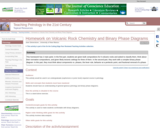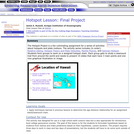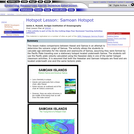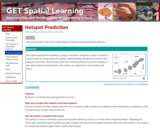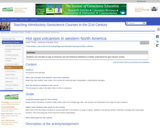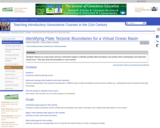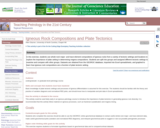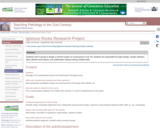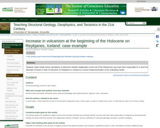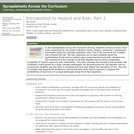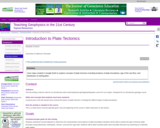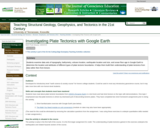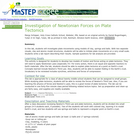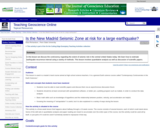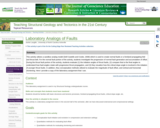Students do background reading on the possible origins of intraplate seismicity and also read Nuttli's 1973 paper on the 1811-1812 New Madrid sequence. They construct frequency magnitude diagrams using data they acquire themselves from the openly archived University of Memphis catalog, Southern California Earthquake Center catalog, and USGS global catalog. They use these diagrams to estimate a recurrence interval for large magnitude earthquakes at the NMSZ. They then split into teams to read papers detailing campaign GPS surveys, paleoseismic measurements, and heat flow measurements. Each team is responsible for summarizing their set of papers for the other students. The culminating assignment is to update Gomberg and Schweig's 2002 USGS pamphlet "Earthquake hazard in the heart of the homeland" using scientific results that postdate the original pamphlet (including their own analysis). We also end with a "teaching and learning discussion" in which the students, who are usually high school teachers themselves, trade ideas about how they could repurpose parts of the lesson for use in their own classrooms. This activity gives students practice in data analysis and reading scientific papers, it shows them a few resources where they can find openly available data, and it gives them a chance to participate in the practice of science.
Teaching Tips
Adaptations that allow this activity to be successful in an online environment
This lesson was constructed specifically for an online course and didn't exist beforehand. I think it could work in a face-to-face course, too.
Elements of this activity that are most effective
Students,especially ones who are not as literate with software plotting / analysis programs, find the problem set somewhat difficult because the datasets are large and I am asking them to collect the data themselves, then use it to make a second-order plot and analyze that, instead of just plotting "A" vs. "B" and analyzing it.
That being said, I know that students are excited to be able to produce a plot themselves that exactly mimics one they can find in a published paper, and furthermore they are happy to find resources such as the USGS earthquake catalog that contain available real-time data.
The part where they have to compare and contrast the strengths and weaknesses of each technique used to study the NMSZ (seismology, paleoseismology, GPS, etc) is important because they get a real sense of how different approaches are important to resolve a scientific debate. I know they are learning something when they get frustrated because there isn't an easy answer!
Recommendations for other faculty adapting this activity to their own course:
-Be prepared to help students get through the technical aspects of some of the scientific papers, especially if they are not used to reading scientific papers. When I pick the papers for them to read, I purposely pick ones that aren't too long (Science, Nature, GRL, etc) and I try to pick ones that came with a press release, "news and views" or similar, and then I tell the students to read the press release first and then the paper.
-Be prepared to give students hints about counting and sorting data to make the frequency-magnitude diagrams because you'd rather lead them towards how to make the plots and then let them get on with the analysis as opposed to letting them get so frustrated with their lack of technical skills that they aren't interested in the science anymore. This exercise should be about seismology; it shouldn't be an excel tutorial! I have a little set of screen capture movie how-to hints under a hidden url, and when I can tell that a student is really suffering I reveal them.
(Note: this resource was added to OER Commons as part of a batch upload of over 2,200 records. If you notice an issue with the quality of the metadata, please let us know by using the 'report' button and we will flag it for consideration.)
